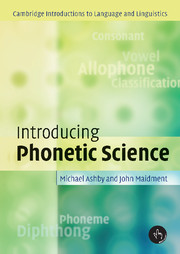2 - Voice
Published online by Cambridge University Press: 05 June 2012
Summary
CHAPTER OUTLINE
In this chapter you will learn about: the structure of the larynx; how the larynx is used to produce voiced and voiceless sounds; how larynx activity can be observed and monitored; the role of voice in the languages of the world; the waveforms of voiced and voiceless sounds.
KEY TERMS
Aperiodic
Complex tones
Cycle
Frequency
Hertz
Larynx
Periodic
Pitch
Sine wave
Voiced
Voiceless
Whisper
Introduction
The basis of all normal speech is a controlled outflow of air from the lungs. Air flows up the trachea (windpipe) and out of the body through the mouth or the nose. On the way it must pass through the larynx, a structure formed of cartilages and visible on the outside of the neck as the ‘Adam's apple’. The airway from the larynx to the lips, and the side-branch via nasal cavities to the nostrils, contain all the organs that control the production of speech sounds, and are known as the vocal tract.
The larynx
We cannot see directly into the larynx, but it can be observed in a mirror placed right at the back of the mouth (a laryngoscope mirror) – for this, the subject must keep the mouth wide open. Another way is with a fibrescope, which can be inserted via the nose and does not prevent the subject from speaking. Both methods give a top view of the larynx, and this is how it is usually shown in pictures and diagrams.
- Type
- Chapter
- Information
- Introducing Phonetic Science , pp. 21 - 32Publisher: Cambridge University PressPrint publication year: 2005



